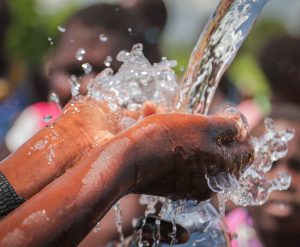Health with Humanity

By Joanna Burke-Bajaj

Within many low-to-middle income countries and communities (LMICs) around the world, women’s health and significant facets of women’s lives are intrinsically tied to water, often through applied social gender roles involving water collection and storage, household labour using water such as laundry, and household water sanitation and hygiene (WASH), (WHO 2014, Hans 2001). Based on women’s close proximity to water usage, many women in communities with underserved water systems have a deeper understanding of needs related to water. Women also face specific health impacts associated with lack of safe access to clean water including those from decreased sanitation and hygiene actions, increased distances walked to collect water, and psychological distress. (WHO & UNICEF 2006, Stevenson et al. 2016). The correlation between lack of clean water and women’s physical and psychosocial stress also emerges as a result of the social and political conditions that women navigate in times of clean water insecurity, as a result of a lack of social status, decision-making power, and representation in leadership (Hulland et al. 2015).
As a result of these rising concerns many global development declarations since the 1990’s, from the Dublin Principles in 1992, the United Nations Rio Declaration of 1992, and the launch of the United Nations 2005-2015 International Decade for Action: Water for Life, have specifically discussed the need to include the role of women in the agenda of improving community access to clean water (Wallace & Porter 2010, Bennett et al. 2008). While these international resolutions seem to illustrate a general consensus that “water is a necessity – and access, control, and use of it are gendered”, still within the communities targeted for clean water improvement, “women’s specific needs in relation to water [are] so often overlooked,” (Wallace & Porter 2010, pp.3). In fact, numerous organizations have noted that understanding women’s needs related to clean water is essential to improving water provision and sanitation, however research assessing women’s governance and social decision-making power as they relate to household use of resources is scarce (Lewis et al. 2005, Kayser et al. 2019). Despite increased global efforts for improvement of both gender equality and clean water accessibility as a result of the Sustainable Development Goals (SDGs), there is still a lack of research surrounding the impact of improvements in the rights of women and gender equality on clean water access specifically – in fact, “in the world of gender policies, water is almost never mentioned,” (Bennett et al. 2008, pp.109). The question then, is how can advancement in the status of women towards gender equality affect the improvement of clean water accessibility in LMIC settings?
“In India, an intervention that involved reserving random local council and government positions for women showed that the women who were given these positions used their new political power to make changes that would address the community needs of other women, including improving ease of access to safe drinking water (Chattopadhyay & Duflo 2004).”
This question must be addressed by reviewing evidence of the types of gender equality interventions that can enhance local clean water systems, and using such information to suggest possible modes by which progress can be made. It is already widely accepted that improvements to the status of women can be used as an intervention to achieve positive development and health-based outcomes (Taukobong et al. 2016). For example, a previous policy study assessed the intervention impacts of key topics identified by the WHO Commission on the Social Determinants of Health through 54 low-income countries from 1990-2012, and established that advancement in gender equality in leadership was associated with an overall increase in life expectancy at birth of 9.4 months (Hauck 2016). There is also existing evidence to support gender equality interventions specifically affecting access to clean water. In India, an intervention that involved reserving random local council and government positions for women showed that the women who were given these positions used their new political power to make changes that would address the community needs of other women, including improving ease of access to safe drinking water (Chattopadhyay & Duflo 2004). An intervention in two rural Burkina Faso locations used gender-segregated groups to discuss clean water concerns, solutions, and action plans, and found that while women had previously been excluded from water management in the area, when given the opportunity for equal leadership they became vocal advocates for local water needs (Impact Initiative 2019).
“Focusing on improving women’s household and community decision-making power, even if not through governance positions, improved clean water accessibility outcomes… women’s empowerment and the improvement of water supply and hygiene are ‘inextricably linked’, (WSSCC, GWA, WEDC & UNICEF 2006).”
Other international research has shown that increasing women’s household and community decision-making power improves multiple local sanitation outcomes, and women’s representation in water leadership positions is a significant predictor of having operational water systems (Kayser et al. 2019). A 2006 report by the Water and Supply and Sanitation Collaborative Council, along with GWA, WEDC, and UNICEF, argued that focusing on improving women’s household and community decision-making power, even if not through governance positions, improved clean water accessibility outcomes and noted that women’s empowerment and the improvement of water supply and hygiene are “inextricably linked”. Overall, when women in low-income settings are empowered to participate in WASH management, their water and sanitation conditions are more likely to become “accessible, safe, and affordable,” (WaterAid Canada 2018).
In conclusion, there is a fair amount of evidence showing how interventions advancing gender equality and women’s leadership can affect improvements to the provision of clean water in low- and middle-income settings, but a paucity of policies putting these interventions into wider action. The positive relationship between advancement of women and clean water accessibility is most clearly actioned in three ways: a) encouraging women to advocate and co-design solutions within communities, as members who closely understand their local needs for clean water, b) increasing women’s decision-making power within households, and c) increasing women’s involvement in local governance and water resource leadership, thereby allowing for greater representation of gendered perspectives and solutions.
Like what you read?
More on Joanna Burke-Bajaj here.
References
World Health Organization (WHO). (2014). Gender, Climate Change and Health. World Health Organization, print. Pp.14. ISBN: 9789241508186.
Hans, A. (2001). Locating women’s rights in the Blue Revolution. Futures, (33)8-9: 753-768.
WHO, UNICEF. (2006).Meeting the MDG drinking water and sanitation target: The urban and rural challenge of the decade. Geneva, World Health Organization and United Nations Children’s Fund. Print.
Stevenson E, Ambelu A, Caruso B, Tesfaye Y, Freeman M. (2016). Community Water Improvement, Household Water Insecurity, and Women’s Psychological Distress: An Intervention and Control Study in Ethiopia.PLoS ONE 11(4): e0153432. https://doi.org/10.1371/journal.pone.0153432
Hulland K, Chase R, Caruso B, Swain R, Biswal B, Sahoo K, et al. (2015). Sanitation, Stress, and Life Stage: A Systematic Data Collection Study among Women in Odisha, India. PLoS ONE10(11): e0141883. https://doi.org/10.1371/journal.pone.0141883.
Wallace T & Porter F. (2010). Introduction. Gender and Development,18(1), 1-10. Accessed from www.jstor.org/stable/25758876.
Bennett V, Dávila-Poblete S, & Rico M. (2008). Water and Gender: The Unexpected Connection that Really Matters. Journal of International Affairs,61(2), 107-126.
Lewis K, Lenton R, & Wright A. (2005). Health, dignity and development – meeting global water and sanitation goals. Id21 Development Research Reporting Service. Print report.
Kayser GL, Rao N, Jose R, & Raj A. (2019). Water, sanitation and hygiene: measuring gender equality and empowerment. Bull World Health Organ. 97(6):438–440. doi:10.2471/BLT.18.223305
Bennett V, Dávila-Poblete S, & Rico M. (2008). Water and Gender: The Unexpected Connection that Really Matters. Journal of International Affairs,61(2), pp.109.
Taukobong et al. (2016). Does addressing gender inequalities and empowering women and girls improve health and development programme outcomes? Health Policy Plan. (10):1492-1514.
K Hauck, S Martin, & P Smith. (2016). Priorities for action on the social determinants of health: empirical evidence on the strongest associations with life expectancy in 54 low-income countries, 1990–2012. Social Science & Medicine, 167:88-98.
Chattopadhyay R, and Duflo E. (2004). Women as Policy Makers: Evidence from a Randomized Policy Experiment in India. Econometrica,72(5), 1409-1443.
Impact Initiative. (2019). ESRC-DFID Research for Policy and Practice: Water Security. The Impact Initiative for International Development Research. The Impact Initiative. Accessed online at https://opendocs.ids.ac.uk/opendocs/bitstream/handle/20.500.12413/14678/R4PP_WaterSecurity_4pp_FINAL_Online.pdf?sequence=1&isAllowed=y
WSSCC, Gender and Water Alliance (GWA), Water, Engineering and Development Centre (WEDC), & UNICEF. (2006). For her it’s the big issue: putting women at the centre of water supply, sanitation and hygiene. WSSCC. Accessed online at https://www.wsscc.org/wp-content/uploads/2016/04/For-Her-Its-the-Big-Issue-Putting-Women-at-the-centre-of-Water-Supply-Sanitation-and-Hygiene-WASH-Evidence-Report.pdf
WaterAid Canada. (2018). Water, Sanitation and Hygiene: A pathway to realizing gender equality and the empowerment of women and girls. WaterAid Canada, Ottawa. Print.

